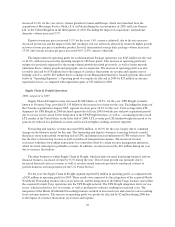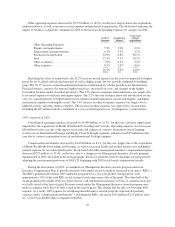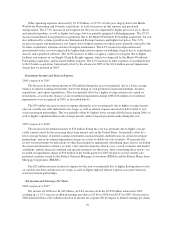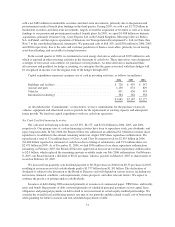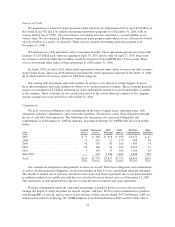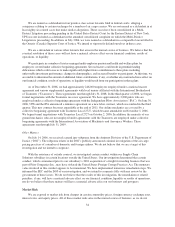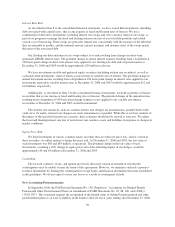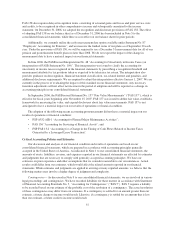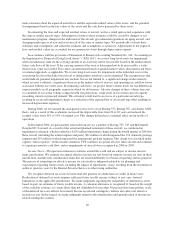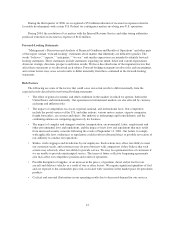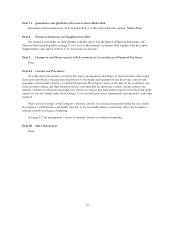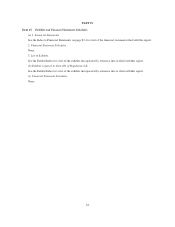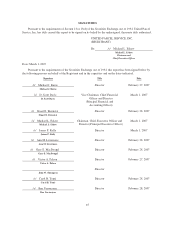UPS 2006 Annual Report Download - page 51
Download and view the complete annual report
Please find page 51 of the 2006 UPS annual report below. You can navigate through the pages in the report by either clicking on the pages listed below, or by using the keyword search tool below to find specific information within the annual report.Interest Rate Risk
As described in Note 8 to the consolidated financial statements, we have issued debt instruments, including
debt associated with capital leases, that accrue expense at fixed and floating rates of interest. We use a
combination of derivative instruments, including interest rate swaps and cross-currency interest rate swaps, as
part of our program to manage the fixed and floating interest rate mix of our total debt portfolio and related
overall cost of borrowing. These swaps are generally entered into concurrently with the issuance of the debt that
they are intended to modify, and the notional amount, interest payment, and maturity dates of the swaps match
the terms of the associated debt.
Our floating rate debt and interest rate swaps subject us to risk resulting from changes in short-term
(primarily LIBOR) interest rates. The potential change in annual interest expense resulting from a hypothetical
100 basis point change in short-term interest rates applied to our floating rate debt and swap instruments at
December 31, 2006 and 2005 would be approximately $29 million each year.
We have investments in debt and preferred equity securities (including auction rate securities), as well as
cash-equivalent instruments, some of which accrue income at variable rates of interest. The potential change in
annual investment income resulting from a hypothetical 100 basis point change in interest rates applied to our
investments exposed to variable interest rates at December 31, 2006 and 2005 would be approximately $12 and
$14 million, respectively.
Additionally, as described in Note 3 to the consolidated financial statements, we hold a portfolio of finance
receivables that accrue income at fixed and floating rates of interest. The potential change in the annual income
resulting from a hypothetical 100 basis point change in interest rates applied to our variable rate finance
receivables at December 31, 2006 and 2005 would be immaterial.
This interest rate sensitivity analysis assumes interest rate changes are instantaneous, parallel shifts in the
yield curve. In reality, interest rate changes are rarely instantaneous or parallel. While this is our best estimate of
the impact of the specified interest rate scenarios, these estimates should not be viewed as forecasts. We adjust
the fixed and floating interest rate mix of our interest rate sensitive assets and liabilities in response to changes in
market conditions.
Equity Price Risk
We hold investments in various common equity securities that are subject to price risk, and for certain of
these securities, we utilize options to hedge this price risk. At December 31, 2006 and 2005, the fair value of
such investments was $80 and $89 million, respectively. The potential change in the fair value of such
investments, assuming a 10% change in equity prices net of the offsetting impact of any hedges, would be
approximately $8 and $9 million at December 31, 2006 and 2005.
Credit Risk
The forward contracts, swaps, and options previously discussed contain an element of risk that the
counterparties may be unable to meet the terms of the agreements. However, we minimize such risk exposures
for these instruments by limiting the counterparties to large banks and financial institutions that meet established
credit guidelines. We do not expect to incur any losses as a result of counterparty default.
New Accounting Pronouncements
In September 2006, the FASB issued Statement No. 158 “Employers’ Accounting for Defined Benefit
Pension and Other Postretirement Plans (an amendment of FASB Statements No. 87, 88, 106, and 132(R))”
(“FAS 158”). This statement requires the recognition of the funded status of defined benefit pension and other
postretirement plans as an asset or liability in the balance sheet for fiscal years ending after December 15, 2006.
36


